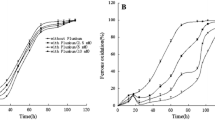Summary
The energetics, enzyme activities and end-product synthesis of Zymomonas mobilis 113 in continuous culture were studied after the shift from an anaerobic to an aerobic environment. Aeration diminished ethanol yield and lactic acid concentration, but increased glucose consumption rate and production of acetic acid. After the shift to aerobic conditions reduced nicotinamide adenine dinucleotide (phosphate) [NAD(P)H]-oxidase activity was stimulated. Washed cell suspensions consumed oxygen with glucose, lactate and ethanol as substrates. The aerobic Z. mobilis 113 regulated their intracellular redox balance by production and reoxidation of the end products, coupled with the formation of NAD(P)H. An increase in transmembrane pH gradient (ΔpH) and a decrease in intracellular ATP concentration were observed after the shift to aerobic conditions. At low medium redox potential (Eh) values the H+ balance was regulated in an energy-independent way via end-product excretion. Under aerobic conditions this was supplemented by ATP-dependent H+ excretion by the membrane H+-ATPase.
Similar content being viewed by others
Abbreviations
- D :
-
dilution rate (h-1)
- S 0 :
-
initial glucose concentration (g/l)
- Y x/s :
-
growth yield (g/mol)
- Y p/s :
-
product yield (g/g)
- q s :
-
specific rate of substrate utilization (g/g per hour)
- q p :
-
specific rate of ethanol formation (g/g per hour)
- qo 2 :
-
specific rate of CO2 production (mmol/g per hour)
- μ:
-
specific growth rate (h-1)
- X :
-
dry biomass concentration (g/l)
- Eh:
-
redox potential of culture medium (mV)
- ΔpH:
-
transmembrane pH gradient (pH units)
- pHin :
-
intracellular pH
- SASE:
-
sum of activities of specific enmymes of Entner-Doudoroff pathway
References
Ackrell BAC, Jones CW (1971) The respiratory system of Azotobacter vinelandii. Eur J Biochem 20:22–35
Baburin LA, Shvinka JE, Ruklisha MP, Viesturs UE (1986) Gas balance method for testing of microbial growth efficiency after carbon substrate pulse. Acta Biotechnol 6:123–128
Beker MJ, Klintsare AA, Shvinka JE, Pankova LM (1984) Bacterial strain Zymomonas mobilis — an ethanol producer (in Russian). Bulletin 32:77
Belaich IP, Senez IC (1965) Influence of aeration and of pantothenate on growth yields of Zymomonas mobilis. J Bacteriol 89:1195–1200
Bringer S, Finn RK, Sahm H (1984) Effect of oxygen on the metabolism of Zymomonas mobilis. Arch Microbiol 139:376–381
Deutsch CI, Kula T (1978) Transmembrane electrical and pH gradients of Paracoccus denitrificans and their relationship to oxidative phosphorylation. FEBS Lett 87:145–151
Gottwald M, Gottschalk G (1985) The internal pH of Clostridium acetobutylicum and its effect on the shift from acid to solvent formation. Arch Microbiol 143:24–46
Huang L, Gibbons LN, Forsberg C (1985) Transmembrane pH gradient and membrane potential in Clostridium acetobutylicum during growth under acetogenic and solventogenic conditions. Appl Environ Microbiol 50:1043–1047
Kalnenieks UZ, Pankova LM, Shvinka JE (1987) Proton motive force in Zymomonas mobilis (in Russian). Biokhimiya 52:720–723
Kobayashi H, Suzuki T, Konoshita N, Unemoto T (1984) Amplification of the Streptococcus faecalis proton-translocating ATPase by a decrease in cytoplasmic pH. J Bacteriol 158:1157–1160
Lowry OH, Rosenbrough NI, Farr AL, Randall RI (1951) Protein measurement with the folin-phenol reagent. J Biol Chem 193:265–268
Lycey CA, Condon S (1986) Active role of oxygen and NADH-oxidase in growth and energy metabolism of Leuconostoc. J Gen Microbiol 132:1789–1796
Pankova LM, Shvinka JE, Beker MJ, Slava EE (1985a) Effect of aeration on the metabolism of Zymomonas mobilis (in Russian). Mikrobiologiya 54:141–145
Pankova LM, Shvinka JE, Beker MJ, Slava EE, Lainis JJ (1985b) Effect of medium redox potential on the metabolism of ethanol-producing bacteria Zymomonas mobilis (in Russian). Izv AN LatvSSR 11:77–80
Pankova LM, Shvinka JE, Slava EE, Beker MJ (1987) Effect of medium redox potential on by-product synthesis in Zymomonas mobilis (in Russian). Prikl Biokhim Mikrobiol 53:795–799
Plevako JA, Bakushinskaya OA (1964) Microbial chemical control of yeast production. Pistchevaya Promyshlennostj, Moscow
Ribbons DW, Dawes EA (1961) Nicotinamide-adenine nucleotide-linked dehydrogenases of Z. mobilis. Biochem J 81:227–228
Summerfield GP, Keenan IP, Brodie NI, Bellingham AI (1981) Bioluminescent assay of adenine nucleotides; rapid analyses of ATP and ADP in red cells and platelets using the LKB Luminometer. Clin Lab Haematol 3:259–271
Swings J, De Ley I (1977) The biology of Zymomonas. Bacteriol Rev 4:1–46
Author information
Authors and Affiliations
Rights and permissions
About this article
Cite this article
Pankova, L.M., Shvinka, J.E. & Beker, M.J. Regulation of intracellular H+ balance in Zymomonas mobilis 113 during the shift from anaerobic to aerobic conditions. Appl Microbiol Biotechnol 28, 583–588 (1988). https://doi.org/10.1007/BF00250417
Received:
Accepted:
Issue Date:
DOI: https://doi.org/10.1007/BF00250417




